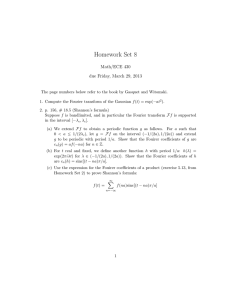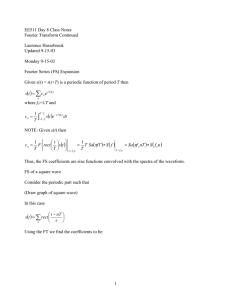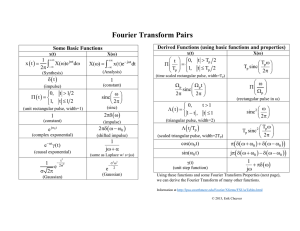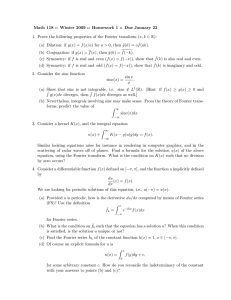Fourier Series and Transform
advertisement
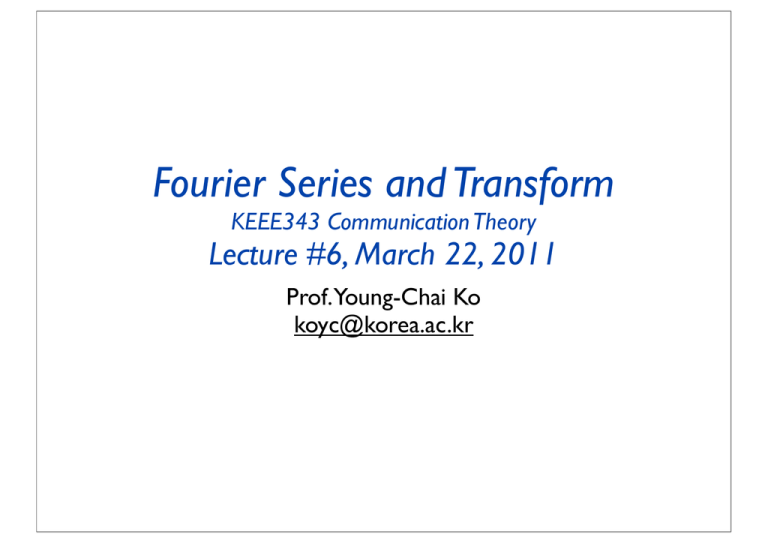
Fourier Series and Transform
KEEE343 Communication Theory
Lecture #6, March 22, 2011
Prof.Young-Chai Ko
koyc@korea.ac.kr
Summary
·•Fourier transform
·• Definition
·• Amplitude and Phase Spectra
·• Properties
·• Examples
Fourier Transform
x(t)
Suppose that is nonperiodic but is an energy signal, so that it ·•is integrable square in the interval .
( 1, 1)
1
·•
x(t)
|t|
T0
In the interval , we can represent as the Fourier 2
series 1
X
x(t) =
n= 1
"
1
T0
Z
T0 /2
x( )e
j2⇥nf0
d
T0 /2
#
ej2⇥nf0 t
f = 1/T
·•where . x(t)
T !1
·•To represent for all time, we simply let such that
0
0
0
nf0 = n/T0
1/T0
P
summation
!
!
!
continuous variable, f
the differential, df
R
integral
•
Thus
x(t) =
•
Z
1
1
Z
1
x( )e
j2⇥f
d
ej2⇥f t df
1
Defining the inside integral as
Z 1
X(f ) =
x( )e
j2⇥f
d
1
•
we can write
x(t) =
Z
1
X(f )ej2
ft
df
1
x(t)
Fourier Transform
X(f )
X(f )
Inverse Fourier
Transform
x(t)
•
Notations
X(f ) = F [x(t)]
x(t) = F
1
[X(f )]
x(t) () X(f )
Amplitude and Phase Spectra
•
•
•
Writing X(f ) in phasor form:
X(f ) = |X(f )|ej
,
(f ) = \X(f )
we can show that for real x(t) , that
|X(f )| = |X( f )| and ( f ) =
(f )
This is done by Euler’s theorem to write
R
I
•
(f )
=
=
<X(f ) =
=X(f ) =
Z
1
x(t) cos(2 f t) dt
1
1
Z
x(t) sin(2 f t) dt
1
Then, the square of amplitude and the phase are
|X(f )|2 = R2 + I 2 ,
✓ ◆
I
(f ) = tan 1
R
•
Amplitude spectrum: Plot of |X(f )| versus f
•
Phase spectrum: Plot of \X(f ) versus f
Example
•
✓ ◆
t
Fourier transform of rectangular pulse g(t) = A rect
T
Z 1
Z T /2
G(f ) =
g(t) exp( j2 f t) dt = A
A exp( j2 f t) dt
1
=
=
=
=
=
=
1
A
exp( j2 f t)
j2 f
T /2
t=T /2
t= T /2
A
[ exp( j2 f T /2) exp(j2 f T /2)]
j2 f
✓
◆
A exp(j f T ) exp( j f T )
f
2j
✓
◆
sin( f T )
A
f
✓
◆
sin( f T )
AT
fT
AT sinc( f T )
Sinc Function
•
Definition
sinc(x) =
sin( x)
x
[Ref: Haykin & Moher, Textbook]
Fourier Transform of Rectangular Pulse
•
Rectangular pulse with the width of T and the height of A so that the area is
at the center of zero
Y✓ t ◆
A
T
! AT sinc(f T )
[Ref: Haykin & Moher, Textbook]
Fourier Transform of Exponential Function
•
Exponential function such as
g(t) = exp(
•
t)u(t)
Fourier transform
G(f ) = F [g(t)]
Z 1
=
g(t)e
j2⇥f t
dt =
1
1
+ j2⇥f
Similarly for g(t) = exp(+ t)u( t)
=
•
G(f ) =
1
j2⇥f
Z
1
0
e
( +j2⇥f )t
dt
Properties of the Fourier Transform
•
Linearity (Superposition) property
then for all constants c1 and c2
c1 g1 (t) + c2 g2 (t)
•
Dilation property
g(at)
•
Proof:
F [g(at)]
! c1 G1 (f ) + c2 G2 (f )
✓ ◆
1
f
⇥
G
|a|
a
Z 1
=
g(at) exp( j2 f t) dt
1
=
=
change of variable:⇥ = at
✓ ◆
Z
1 1
f
g(⇥ ) exp j2
⇥
a 1
a
✓ ◆
1
f
G
a
a
d⇥
•
Reflection property
g( t)
! G( f )
[Ref: Haykin & Moher, Textbook]
•
Conjugation rule
Let g(t)
! G(f ) , then for a complex-valued time function g(t)
g ⇤ (t)
! G⇤ ( f )
Prove this:
g ⇤ ( t)
! G⇤ (f )
•
Duality property
If g(t)
! G(f ) , then G(t) ! g( f )
Z 1
g( t) =
G(f ) exp( j2 f t) df
1
which can be expanded part in going from the time domain to the frequency
domain:
Example of Dual Property: Sinc Pulse
•
We have the following pair of the Fourier transform:
g(t) = A sinc(2W t)
•
A
! G(f ) =
rect
2W
✓
f
2W
◆
Then, if the time function, given as
h(t) = G(t) =
A
rect
2W
✓
t
2W
◆
! H(f ) = g( f ) = A sinc( 2W f ) = A sinc(2W f )
•
Time shifting property
If g(t)
•
t0 )
! G(f ) exp( j2 f t0 )
Frequency shifting property
If g(t)
•
! G(f ) , then g(t
! G(f ) , then exp(j2 fc t)g(t)
Area property under g(t)
If g(t)
! G(f ) , then
Z
1
1
g(t) dt = G(0)
! G(f
fc )
Example of Frequency Shifting Property
•
Find the FT of radio frequency pulse given as
✓ ◆
t
g(t) = rect
cos(2 fc t)
T
Using the Euler’s formula we have
1
cos(2 fc t) = [exp(2 fc t) + exp( j2 fc t)]
2
Then using the frequency shifting property of the Fourier transform we get the
desired result:
✓ ◆
t
T
rect
cos(2 fc t) ⇥⇤ {sinc[T (f
T
2
fc )] + sinc[T (f + fc )]}
[Ref: Haykin & Moher, Textbook]
•
In the special case of fc T >> 1, that is, the frequency fc is large compared
to the reciprocal of the pulse duration T - we may use the approximate
result
G(f ) =
8
<
:
T
2
sinc[T (f
T
2
sinc[T (f + fc )],
fc )],
0,
f >0
f = 0,
f <0
•
•
Area property under G(f )
Z
g(0) =
1
G(f ) df
1
Differentiation in the time domain
If g(t)
! G(f ) , then
d
g(t)
dt
! j2 f G(f )
and
dn
g(t)
dtn
! (j2 f )n G(f )
•
Modulation theorem
Let g1 (t)
! G1 (f ), and g2 (t)
g1 (t)g2 (t)
•
!
Z
1
! G2 (f ) , then
G1 ( )G2 (f
)d
1
Convolution Theorem
Z 1
g1 ( )g2 (t
1
g1 (t) ⇤ g2 (t)
)d
! G1 (f )G2 (f )
! G1 (f )G2 (f )
•
Correlation theorem
Z
•
1
1
g1 ( )g2⇤ (t
)d
! G1 (f )G⇤2 (f )
Rayleigh’s Energy theorem
Z
1
1
|g(t)|2 dt =
Z
1
1
|G(f )|2 df
[Ref: Haykin & Moher, Textbook]
